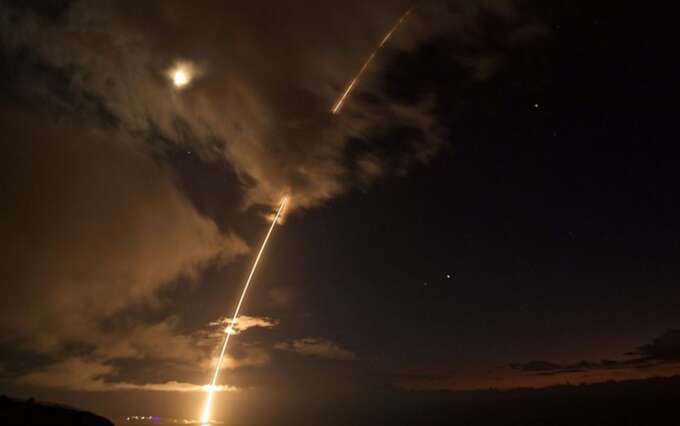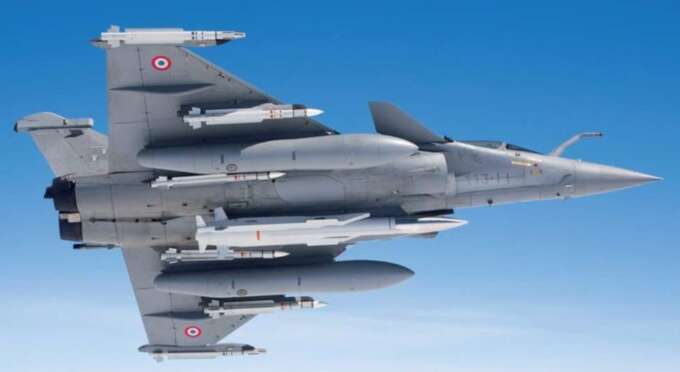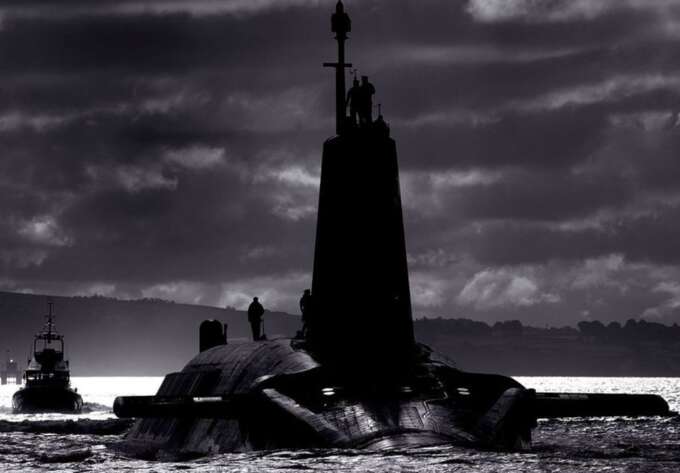
Russian propagandists are once again threatening Europeans with the “death of civilization,” and for the first time, Vladimir Putin is backing up his traditional nuclear saber rattling with actual exercises of non-strategic nuclear forces.
Putin has also suggested that Europe would struggle to counter any hypothetical Russian aggression without U.S. support, a possibility Europeans themselves have begun to take seriously. Still, even if Donald Trump were to win the upcoming U.S. election and the new president really did take the step of withdrawing America’s security guarantees to European NATO members, the continent retains significant nuclear capabilities of its own — and is already preparing for a potential future without American backing.
A new round of nuclear blackmail
Vladimir Putin has embarked on a new round of nuclear blackmail, only this time the threatening statements are accompanied by actions focused squarely on Europe.
In late May 2024, while answering questions from journalists, Putin urged Europeans to remember that they live in “states with small territories and very dense populations” and that they ought to take “this factor” into account when considering allowing Ukraine to use Western long-range precision weapons against targets deep inside Russia’s internationally recognized territory.
Then, at the St. Petersburg International Economic Forum in early June, Putin started making more transparent threats. Firstly, he emphasized Europe’s “defenselessness” against a possible strike because, unlike the United States and Russia, the continent is not protected by a well-developed anti-satellite weapons (ASAT) system. Secondly, the Russian leader explicitly stated the power of the tactical nuclear weapons at his disposal and spoke to Russia’s quantitative superiority in this category:
“Our tactical nuclear weapons are four times more powerful than the bombs used by the Americans against Hiroshima and Nagasaki. Three or four times! We have many times more of them in terms of numbers — both on the European continent, and even if the Americans bring their own from the United States, we still have many times more.”
Thirdly, Putin touched on the very important and painful issue of the possibility of a nuclear war involving strategic warheads, expressing doubts that the Americans would intervene in the event that Europe came under a full-scale Russian nuclear attack:
“If those with whom we will exchange such strikes no longer exist, will the Americans get involved in this exchange of strikes at the level of strategic weapons or not? I doubt it very much, and the Europeans should think about this.”
In addition, Putin announced the willingness to implement changes to Russia’s Doctrine on the Use of Nuclear Weapons and nuclear testing if the need arose. All of the above could be attributed to the information warfare rhetoric that has already become traditional during the war in Ukraine, but this time the words have also been accompanied by actions — albeit largely symbolic ones.
On May 21, 2024, Russia commenced its first-ever exercises of non-strategic nuclear forces. In the initial stage, troops from the Southern Military District practiced receiving nuclear warheads for Iskander systems, transporting them to designated strike areas and equipping Kinzhal missiles with the warheads.
The second stage of the exercise, also conducted in Belarus, saw the involvement of naval forces and attack aviation alongside the Iskanders. Notably, during a parade in Minsk, Iskander missiles adorned with radiation hazard emblems were prominently displayed.
Equally significant is the resurgence of nuclear threats on Kremlin-controlled domestic television channels after a lengthy hiatus. On the state-owned Rossiya 1, presenter and MP Yevgeny Popov addressed the U.S. plan to deploy land-based intermediate-range and shorter-range missiles to Germany, warning that “almost all European capitals” would be at risk, as “three missiles” fired by Russian forces could suffice to obliterate a civilization like the United Kingdom.
Back in February, the Financial Times published a story referring to secret Russian military planning documents and war game scenarios dating from 2008-2014. The documents suggested that the Russian threshold for the use of tactical nuclear weapons is much lower than is usually stated by the Kremlin.
The criteria for first use included an enemy invasion of Russian territory, the destruction of 20% of Russia’s ballistic missile submarines, 30% of its cruise missile submarines, three or more naval cruisers, or three air bases — and even mentioned the potential for use of tactical nuclear weapons to prevent defeat in a single battle.
How is the West reacting?
In January 2024, some European politicians began advocating for an independent European nuclear deterrent against Russia, especially given the uncertainty surrounding NATO’s future, which many believe hinges on the outcome of this November’s U.S. presidential election. Germany, in particular, seriously considered “buying” up to 1,000 decommissioned U.S. warheads and deploying them across European NATO member territories.
By spring, Polish authorities had expressed their willingness to host nuclear weapons as a countermeasure to Russia’s deployment of tactical nuclear weapons in Belarus. In June, NATO Secretary General Jens Stoltenberg confirmed that alliance members were consulting on moving nuclear warheads out of storage and placing them on standby.
Ahead of this past July’s NATO summit in Washington, DC, the White House announced that the U.S. would deploy intermediate-range and shorter-range missiles, including SM-6 multirole missiles, Tomahawk cruise missiles, and advanced hypersonic missiles (still under development), in Germany starting from 2026. This would mark the first such deployment since the Cold War.

SM-6 missile launch from the US destroyer USS John Paul Jones, 29 August 2017.
Photo: Latonja Martin / U.S. Navy
Although these are non-nuclear missiles, there is little doubt that they could be equipped with nuclear warheads. Notably, the Strategic Offensive Arms Treaty between Russia and the United States, which limits the number of deployable nuclear weapons, is set to expire in early 2026. It is unlikely to be replaced by a new agreement — particularly if both sides start deploying intermediate-range and shorter-range missiles. “Taking into account the combined capabilities of NATO member countries, we have to calibrate our responses without any internal constraints in terms of what, where, and when we can, should, and must deploy. That is the widest possible optionality,” commented Russian Deputy Foreign Minister Sergei Ryabkov.
Given that Donald Trump’s chances of winning the election remain substantial, discussions about ensuring Europe’s security absent the guarantee of American involvement are intensifying. The U.S. nuclear umbrella has allowed European countries to economize on costly nuclear weapons programs since World War II, raising the question of whether Europe’s own nuclear capabilities will suffice to deter Russia if the U.S. under Trump adopts an isolationist foreign policy or focuses on confronting China.
The nuclear capabilities held by London and Paris — and the scenarios for their use
In Europe, both the UK and France possess strategic nuclear arsenals, numbering 225 and 290 warheads respectively. However, the UK’s strategic nuclear forces are heavily dependent on the U.S., as the Trident missiles on Britain’s Vanguard-class submarines are manufactured by American company Lockheed Martin.
The UK is also not a member of the European Union, and neither France nor the UK has a nuclear triad. France relies on strategic submarines and Rafale fighter-bombers, with a total of 48 submarine-launched ballistic missiles and about 50 air-launched missiles, while the UK relies solely on submarines.

payload.
Photo: MBDA
France has historically developed its nuclear program independently, and is now the only NATO member that is not part of the alliance’s Nuclear Planning Group. Therefore, it is Paris that is poised to take a leading role in the potential European nuclear deterrence system should America absent itself. However, the French nuclear doctrine is focused on protecting only French “vital interests,” having been designed to prevent a nuclear strike on French “national territory” — or a Soviet invasion.
France’s nuclear doctrine is based on protecting only French “vital interests” with nuclear weapons
Whether French “vital interests” encompass the security of other European countries, potentially extending the “Maginot nuclear line” to the borders of the EU or NATO, remains a matter of political interpretation. Additionally, France adheres to the principle of “strategic uncertainty” regarding its conditions for nuclear weapon use, leaving the exact triggers ambiguous.
Back in 2020, Emmanuel Macron declared that the country’s “vital interests” had a “European dimension” and later reaffirmed this position by offering the rest of the continent a “strategic dialogue” on the topic — but his successor as president may have a different view on the matter.
Unlike France, Britain’s nuclear doctrine explicitly mentions using nuclear weapons in exceptional circumstances to defend not only the UK, but also its NATO allies. However, Britain’s nuclear force is more vulnerable than France’s, with the capability to deploy only one ballistic missile submarine (SSBN) on alert at a time.
The UK’s nuclear doctrine mentions using nuclear weapons to defend its NATO allies
Vladimir Putin, however, specifically addressed tactical nuclear weapons (TNWs), which are small nuclear charges intended for battlefield use without causing widespread radioactive contamination. Unlike strategic nuclear weapons, TNWs have never been subject to arms reduction and control treaties. According to rough estimates, the Kremlin may have up to 2,000 tactical nuclear charges, which can be deployed via sea-, land-, and air-based missiles, aerial bombs, torpedoes, and even artillery shells.
Both France and the UK are known to have dismantled their tactical nuclear weapon stockpiles, though French cruise missiles capable of carrying nuclear warheads generally meet the characteristics of TNWs. At the same time, French doctrine does not envision using nuclear weapons on the battlefield. Instead, it considers medium-range air-to-surface ASMP missiles to be pre-strategic weapons, serving as a “last warning” to signal France’s readiness to escalate to longer range sea-based ballistic missile strikes, thereby restoring nuclear deterrence. Of course, such a concept has not yet been tested in practice, so it is difficult to predict how a potential adversary might react to a limited nuclear strike.
In contrast, American B61 bombs, which are deployed at six bases in Germany, Italy, Belgium, the Netherlands, and Turkey, are pure tactical warheads. Though these bombs currently have more symbolic than combat value, they are being upgraded to the B61 Mod 12, equipped with a guidance system similar to the JDAM module.
Given that Russia and the United States each possess over 5,000 nuclear warheads, the capabilities of France and the UK may seem minor. However, when it comes to deterrence, it is not the total number of warheads that matters, but the determination to use them — along with their physical capacity to reach targets on enemy territory.
What matters for deterrence is not the total number of warheads, but the determination to use them
What about the missile warning system?
Putin separately claimed that the Europeans do not have their own ballistic missile warning system. However, the mere existence of French and British SSBNs ensures the inevitability of a retaliatory strike, as it is virtually impossible to detect and destroy all ballistic missile-carrying submarines — unlike land- and air-based systems.
Traditionally, upon taking office, the new UK Prime Minister writes letters to the captains of SSBNs, instructing them on how to proceed if the British military and political leadership is annihilated in a nuclear attack. The survivability of these submarines thus acts as a nuclear deterrent in its own right.

The Royal Navy’s HMS Vengeance, a Vanguard-class SSBN carrying the Trident ballistic missile — the UK’s nuclear deterrent.
Photo: Royal Navy
Meanwhile, the effectiveness of Russia’s missile warning system, SPRN (СПРН), is questionable. The Kupol EKS (“Edinaya Kosmicheskaya Sistema” or “Integrated Space System”), which is supposed to fulfill this role, reportedly has only four satellites in a highly elliptical orbit — as opposed to the planned for ten — along with a few geostationary ones. Kupol also does not meet the primary criterion for SPRN in terms of providing sufficient warning time for the launch of attacking ballistic missiles, given their approach time.
Is Europe ready for a nuclear response without the United States?
Vladimir Putin’s threats are clearly aimed at getting Western allies to not extend aid to Ukraine — in other words, it looks like another one of the Kremlin’s infamous “red lines.” The Insider has previously detailed the Kremlin’s strategy for drawing “red lines” — and their debatable effectiveness in warfare. This time, however, the focus is on more fundamental and long-term challenges to European security if the U.S. were to refuse to defend Europe from Russian aggression.
Absent U.S. military power, the conventional advantage of NATO’s European members over Russia is not clearly overwhelming, and the obvious disparity in nuclear forces between Russia and Europe is of key importance. Moscow’s undisputed supremacy in this category increases the likelihood of Russia using tactical nuclear weapons to force a European adversary into negotiating favorable terms and thus avoid conventional war, aligning with the Russian “escalation for de-escalation” strategy analysts have described.
Be that as it may, Europe is preparing: informed sources indicate that more and more European politicians are asking their French colleagues about the potential architecture for a pan-European nuclear deterrent independent of the EU or NATO. The UK decided as early as 2021 to increase its nuclear warhead count to 260. However, it is important to note that France, with presidential elections scheduled for 2027, has its own potential Trump-like figure in Marine Le Pen. According to the manifesto of Le Pen’s National Rally party, French nuclear weapons are intended solely for the defense of France, excluding guarantees for third countries.
It is hardly possible to speak seriously about the emergence of a pan-European nuclear arsenal or the acquisition of nuclear weapons by a new European country. Such programs are incredibly expensive and require a commitment of 25-30 years. Therefore, reliance will likely remain on the French and British arsenals. However, in the event of a genuine threat of the U.S. withdrawing its security guarantees to Europeans under Donald Trump, the European theater will still have some level of deterrence:
- France and the UK possess a total number of nuclear warheads that exceeds that of China, the third-largest (after the U.S. and Russia) nuclear power in the world. One of these countries is notably both a member of both the EU and NATO, while the other is only a member of NATO;
- The UK’s nuclear doctrine includes a clause on the defense of its NATO allies with nuclear weapons;
- The existing infrastructure for deployment and maintenance of nuclear warheads in at least five countries: Germany, Italy, Belgium, the Netherlands, and Turkey;
- Crews of nuclear-capable aircraft from the above countries, as well as from Greece, trained under the separate Nuclear Sharing program.
The above provides a solid foundation for a pan-European nuclear deterrence initiative, and it is reasonable to imagine that such a coordinated European response would materialize in response to any significant threat to the continent’s security. For instance, the French “strategic dialogue” project announced by Emmanuel Macron could be swiftly transformed into a functional mechanism for joint pan-European nuclear planning. This could involve achievable steps such as establishing a consultative body with European allies, involving them in the operations of French nuclear forces, or deploying French nuclear weapons to countries like Germany or Italy in place of American ones.
This is why, despite Europe’s numerical disadvantage, some experts have argued that its real security problem lies not in the realm of nuclear forces, but in conventional weapons. The Insider has explored this issue in detail in a separate piece.
This article was originally published in Russian on July 19, 2024.
Read more similar news:
Comments:
comments powered by Disqus
































